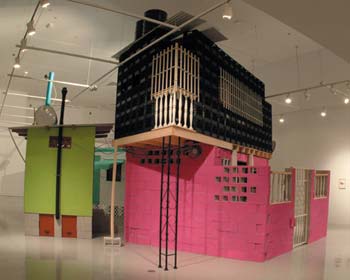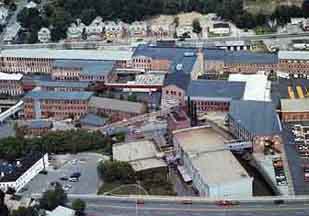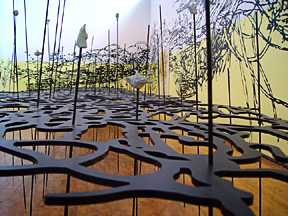Marjetica Potrc’s Urgent Architecture at the MIT List Visual Arts Center is so practical and so “green” that it would be very difficult to distinguish this exhibition from what one would find in a display on energy conservation. Upon entering the List the only objects that put this art viewer at home were the marker drawings, rough architectural sketches with cryptic captions that half illuminate each sketch. Suspiciously, the drawings are beautiful, colorful, and laid out on toothy paper. They are not the loose notes that one might claim they are. The drawings, along with other wall text, suggest that Portc has been to or at least thought about every major city on earth (yes, there is a sketch devoted to Boston), and with a kind of global/local attention she travels abroad with the world as her studio.
On one wall a shelf holds a collection of small objects that pertain to energy conservation, among them a flashlight that runs on stored solar power and a hand-wound charger for a cell phone. This collection is perplexing in an art gallery. It is not the Duchampian presentation of a found object or the critical presentation of a collection, à la Heim Steinbach or even Mark Dion. Why are we asked to associate these objects with the name Marjetica Potrc? Ironically, one actually begins to wonder if Potrc had a hand in their design. The answer must be no, right?
Next to the collection a video clip from BBC news reports on the success of one such item, the Hippo Water Roller, that has aided many citizens in Johannesburg, South Africa in collecting water from local wells. It is made of a simple bent pole attached to both sides of a tough barrel. The Hippo’s ingenious design means that when the barrel is on its side the whole system (barrel filled with water) can easily be rolled back home.
The larger second room is filled with an actual home, complete with outhouse. Among other things, it is constructed from crates, cinderblocks, reused wood and siding. Potrc and her small team recently constructed a similar outhouse like the one in the installation at a shantytown in Caracas, Venezuela. A taped interview with the artist (presented in the backyard of the installation) explains that the outhouse contains a dry toilet that helps the villagers conserve precious water while simultaneously improving the quality of life at the shantytown. Potrc was able to construct the toilet with mostly common findable/affordable materials while involving the labor of the locals.
It is in the interaction with the shanty-dwellers where Potrc attempts to locate her art practice. By working in a manner that tries to integrate the locals’ shantytown into the accepted notion of city space, while still demonstrating improvements to their way of life, Potrc places herself in the dual role of advocate and educator. In an interview with Hans Ulrich Obrist she states, “I see beauty both in gated communities and in shantytowns, and in both cases it’s kind of primitive.” In Urgent Architecture her advocacy is on one hand in line with the practice of self-sustainable architecture and on the other, and probably more importantly, notable for its active acceptance of what has been a distressing model of current urban extremes. Gated community and shantytown are both models that she tries to assimilate and graft onto an ecologically green notion of what a city is. Her refusal to see the “facts of contemporary urban life” in a negative light alleviates the pressure that may cause places like shantytowns and other urban voids to be seen as such huge problems that they become ignored. For this reason she has built a dialogue between herself and any number of global/local groups, some in shantytowns and some in art galleries.
Still, it is easy to see Potrc as a cowboy, coming to town, solving a problem none asked her to, and then riding off into the sunset. Would her toilet really work in the shantytown environment or will it become so infested with bugs that it is more problem than solution? Or worse, will community property in a community without laws become a battleground between families?
This brings me back to the art gallery and one particularly revealing detail. The doors to the hacienda were locked. No one could enter to find out how inhabitable the private space really was. In this way Potrc kept skeptical minds churning and a big “?” hanging in the air. Could we live in Potrc prescribed home, and in a future of limited water and resource might we actually have to?
Links:
MIT List Visual Arts Center
"Marjetica Potrc: Urgent Architecture" was recently on view at the MIT List Visual Arts Center, 20 Ames Street, Building E15, atrium level, Cambridge, MA.
All images are courtesy of the Marjectica Potrc and the MIT List Visual Arts Center.
Roy Stanfield is an artist from Texas so he knows a cowboy when he sees one. See more: home.earthlink.net/~roystanfield; ask more: wroistanfield@yahoo.com.




